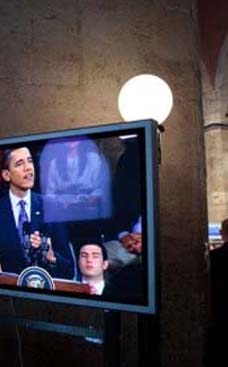
Jack’s penchant for preservation grew out of an experience he had in Tunisia while serving in the Peace Corps. Troubled that the Tunisians were destroying centuries of history in the name of modernization, Jack met with civic leaders and convinced them to adopt a plan to restore crumbling buildings, converting them into museums, hotels, and tourist attractions. Among the first structures he rebuilt under the plan was the Mosque Maklouf in LeKef Tunisia: after that, Jack always received the goat’s eye at dinner.
Obituary for Tunisia RPCV Jack Tucker
LR native architect dies
It's a day for deaths of note. Comes word now of the death of Jack Tucker, 70, a Little Rock native and UA-educated architect, credited with revival of downtown Memphis, beginning with the first condo conversion of a former cotton warehouse. A full account of his life follows.
PREPARED RELEASE
Jack Tucker was a modernist architect possessed of a deep love and appreciation for older buildings. In 1975, he combined these two seemingly diverse interests with results that would leave Memphis forever changed.
He was the architect, and co-developer, of downtown’s first condominium conversion, The Timpani Building, a former cotton warehouse at 41-43 Union Avenue. With its ground level retail and office space, and two floors of living spaces above, Tucker’s transformation of the decaying building was the first multi-use rehabilitation project in downtown Memphis.
Jack battled tirelessly for good urban design, especially when fighting for the Cotton Row Historic District that he called home. At his front door, he fought to design what is arguably the most attractive sidewalk in Memphis (along Union from Front to Wagner); at his back door, he famously defeated the city’s plans to replace the original cobble stones in the alleys leading from Front Street to the River with a pinkish colored concrete block called Bowmanite. His victory over city planners was won by having Cotton Row added to the National Register of Historic Places, trumping the city’s ability to influence changes and allowing him to substitute his own designs for the area.
Jack’s penchant for preservation grew out of an experience he had in Tunisia while serving in the Peace Corps. Troubled that the Tunisians were destroying centuries of history in the name of modernization, Jack met with civic leaders and convinced them to adopt a plan to restore crumbling buildings, converting them into museums, hotels, and tourist attractions. Among the first structures he rebuilt under the plan was the Mosque Maklouf in LeKef Tunisia: after that, Jack always received the goat’s eye at dinner.
His dedication to preservation, however, was never at odds with his modernist training. Jack was a student, and later employee, of the famed E. Fay Jones, who himself was the favorite apprentice of Frank Lloyd Wright. After moving to Memphis, Jack joined the firm of Roy Harrover, designer of the airport, with whom Jack worked closely on building the Mud Island River Park and Ampitheatre. More recently, his involvement with Mud Island took on something of a preservationist tone when he was asked by the River Front Development Corporation to design a structure which may someday house the old Fairgrounds carousel at a new site proposed on the Island.
In nominating Jack for a Fellowship with the American Institute of Architects, Roy Harrover credited Jack Tucker, “with having more to do with saving downtown Memphis than any other person,” calling Jack a, “tireless advocate of urban living, adapting buildings that had outlived their original purpose to new uses, saving them and preserving the city’s urban fabric.”
For a number of years the Timpani Building remained the only example of downtown’s rehabilitation that the Center City Commission could show developers; “They about wore my floors out with their tours,” Tucker often joked. The list of buildings adapted by Jack grew, however, to include The Candy Factory, The Scimitar Building, The Memphis Convention and Visitors Bureau, The Pontotoc Building, The Child Advocacy Center (former Four Flames), the upper level of Charlie Vergos’ Rendezvous, as well as the Lennox School (in Midtown), to name but a few.
Always keenly aware of the latest developments in building materials and techniques, Jack also designed a significant number of new modernist spaces for libraries, schools, housing, commercial, office and institutional use, but he steadfastly maintained that “reusing an existing structure is the greenest building method of all.”
Born in Little Rock, Arkansas, in 1939, Jack graduated from the University of Arkansas in 1963 with a Bachelor of Arts & Bachelor of Architecture. He became principal of his own architecture firm, Jack R. Tucker, Jr. & Associates Architects in1979, winning dozens of professional awards from national, regional and local organizations.
Jack was an accomplished photographer and sculptor, as well as an enthusiastic developer of Bonsai. He was a member of the University of Arkansas’ School of Architecture’s Advisory Board, Dean’s Circle, and held the school’s John G. Williams Fellowship. In addition to being a Fellow of the American Institute of Architects, Jack served as former President of AIA’s Memphis chapter. He was a former Chairman of the Memphis Landmarks Commission; a founding member & past President of Memphis Heritage; a founding member and architectural consultant to Friends For Our River Front; a founding member and past President of the Downtown Neighborhood Association, a founding member and past President of the Chickasaw Bluffs Conservancy, and a member of the Center City Commission Policy Committee for the Downtown Development Plan.
He succumbed quietly to the cancer he had held at bay for the past year, shortly after Midnight on the morning of Sunday, April 5. He spent his last night among friends in the rehabilitated building that sparked the revitalization of Downtown Memphis.
Jack Tucker, visionary and urban pioneer, leaves behind his beloved wife, Cyndy Grivich Tucker, of Memphis; as well as his mother, Amanda Davis Tucker, a nephew, Ren Tucker, and a niece, Lauren Garaputa, all of Little Rock Arkansas; his devoted dogs, Mati and Joy, the boxers who guard the balcony on Union near the River; and the thousands of people who followed him to live in downtown Memphis.
The date for a memorial service celebrating Jack’s life will be announced soon.











